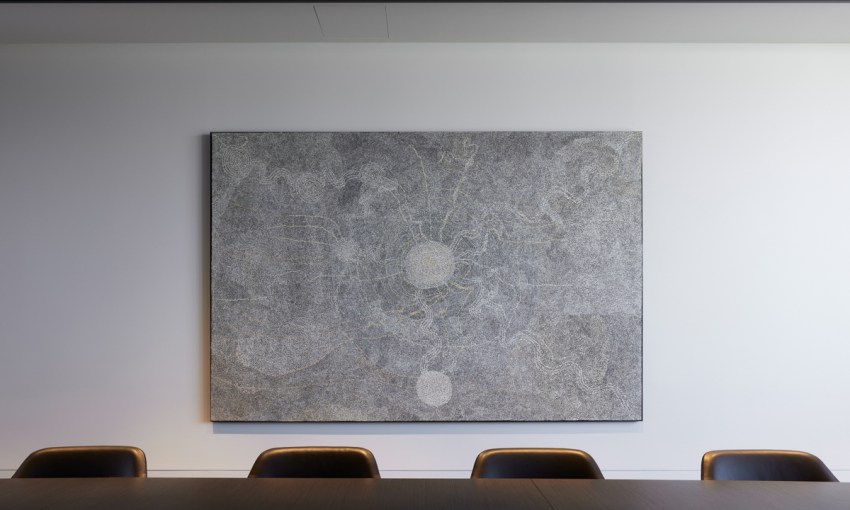Architects Walter Brooke have curated and commissioned a broad array of South Australian artworks and objects for the SkyCity-owned hotel.
EOS is secretly a great South Australian contemporary art gallery
CityMag meets Walter Brooke director Mark Berlangieri at the ground level of EOS, the recently opened upmarket SkyCity Hotel.
Much of the artwork discussed in this piece is available for the public to view when visiting EOS.
For more information on the building, see the website.
Those who cashed in their Great State vouchers here may initially have been won over by the curved, golden façade and the calming muted interiors, but over the course of their stay they may also have gained a new appreciation for South Australian art – maybe even without knowing it.
Part of Walter Brooke’s pitch for the EOS project was to include a South Australian perspective throughout the interior space through the selection of artworks.
This was intended to complement the views across city and contrast against the company as an international entity as well as the material selections that have come from further afield.
As we prepare for our tour of the space, Koi fly across the enormous screens above the elevators – a work produced by creative studio Kojo.
This piece is not part of Walter Brooke’s larger collection – curated with the help of philanthropist Tracey Whiting – but it’s indicative of the surprising ways South Australian art has been used throughout the property.
The first space we’re led to is the lounge area where guests will arrive to check in.
Here, there are works by renowned South Australian artist and the artistic director of Tarnanthi, Nici Cumpston, including her photographic works titled Winter.
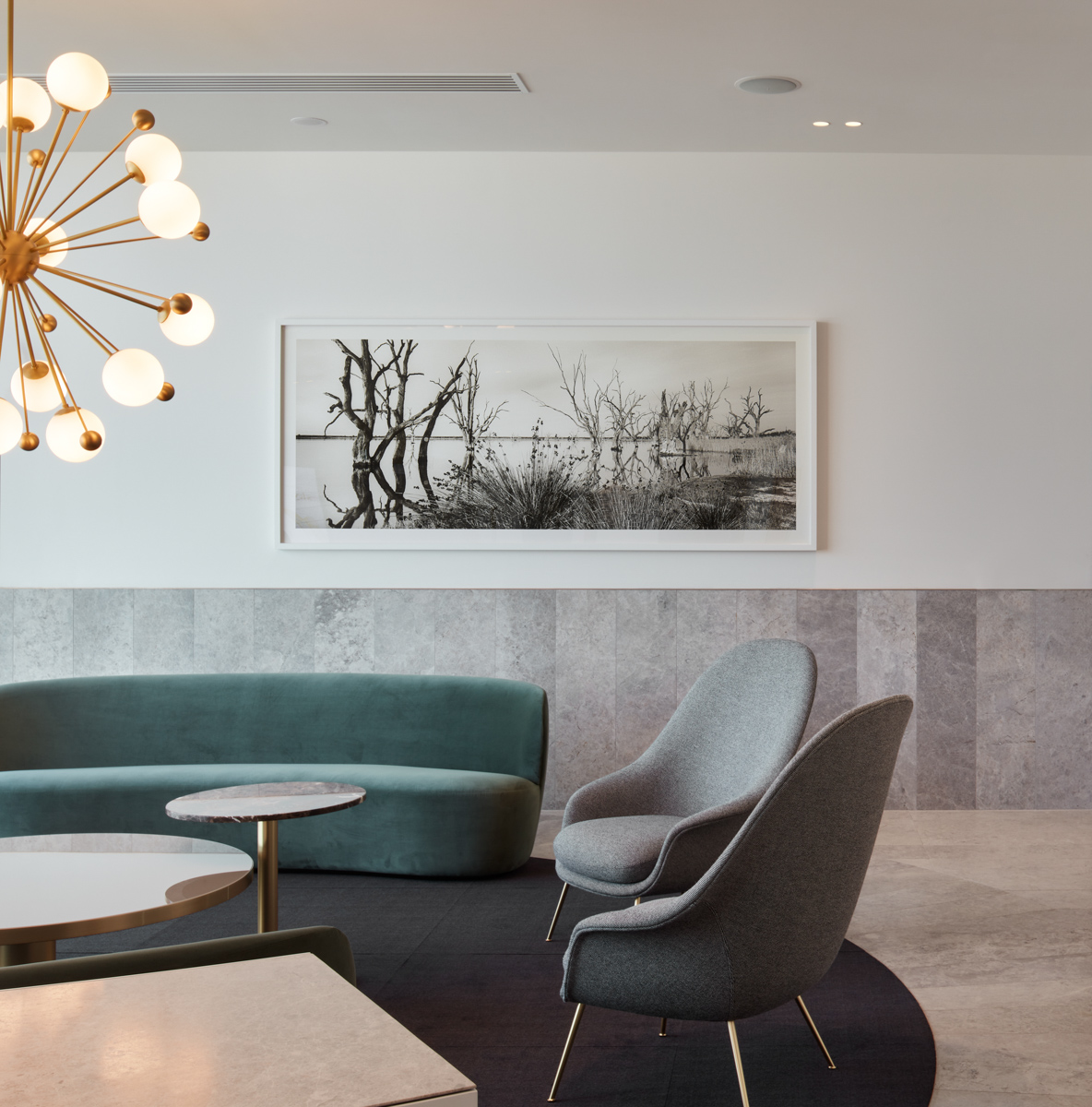
Nici Cumpston’s work in EOS
“The difference [in] that piece is it’s a photograph that she hand-paints over top,” Mark explains.
“This is one of the most significant pieces in the collection, and was really selected because we wanted to show a different point of view of Adelaide and its landscape.”
Where many hotels across the city and state will opt for familiar views of the Australian landscape – think shots of vineyards in the Barossa or the rolling Adelaide Hills – Mark has taken the opportunity to present South Australia away from the tourism marketing department and into the hands of artists.
“Most of the artwork, from day one, we really talked about it being a South Australian perspective, so not necessarily vine leaves,” Mark says.
Some of the decisions, though, were also driven to complement the aesthetic created through the interior design.
“A lot of the artwork was really selected to complement the interior. It’s quite soft and natural, the palette is pretty much black or white or neutral tones the whole way through,” Mark says.
A colourful piece from Amata artist Wawiriya Burton juxtaposes against the stark monochromatic work from Nici Cumpston, but there is little more Mark can tell us about the work.
“The fun thing about that is we don’t actually know what it’s about,” he says.
“It’s a secret, so you can see it but you can’t talk about it. So it’s of the land, and that’s all we really know.
“We thought it was interesting to have someone that senior in South Australia represented in the collection.”
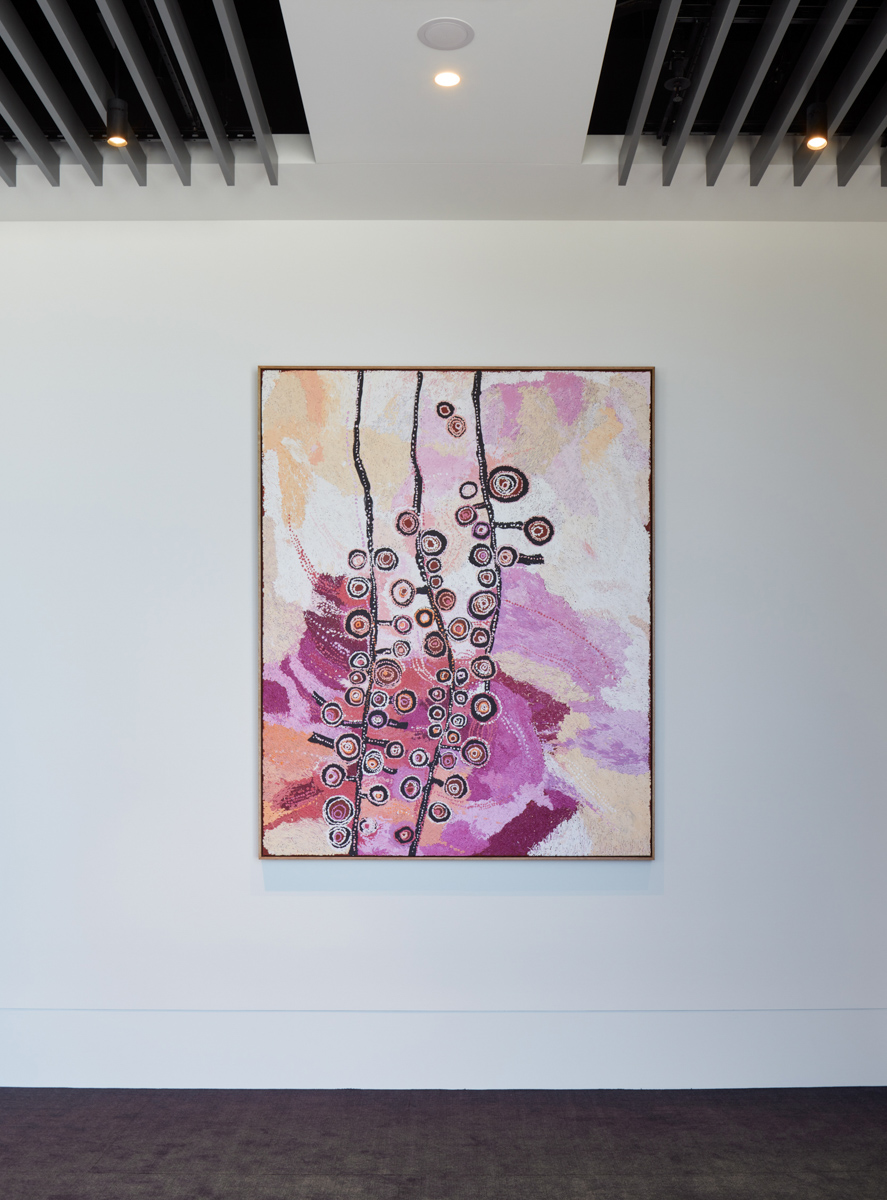
Wawiriya Burton’s piece, the meaning of which remains secret
Further down the corridor is a commissioned piece by APY Lands artist Mick Wikilyiri, called Blue Spears.
“And again, it was more about showing Aboriginal art in a more contemporary way, so these are quite abstract,” Mark explains.
Now en route to the pool floor, we head towards the elevator. In front of the elevator door on every level is a display box featuring smaller items made by local craftspeople from institutions such as JamFactory and Greenaway Art Gallery.
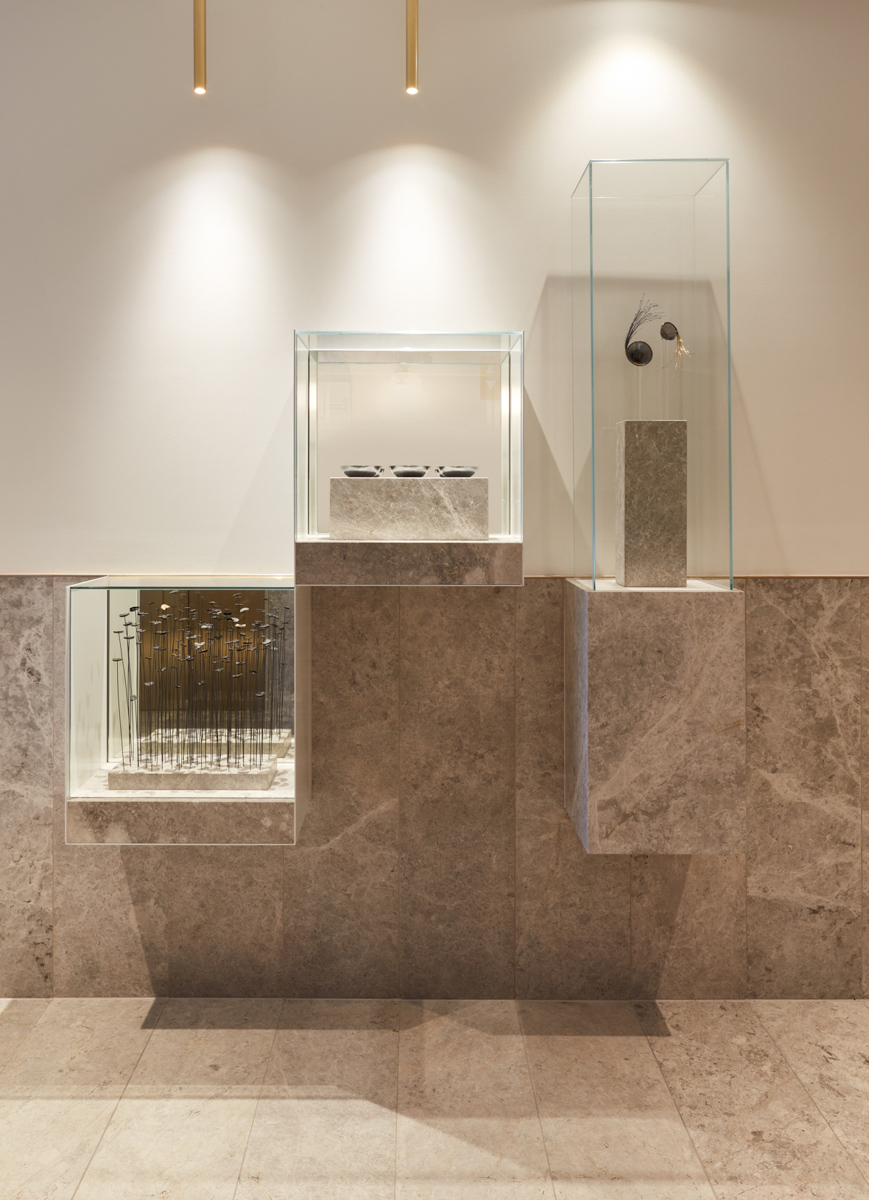
Mark points out a bronze piece from Danny Fotopoulos, and later on in our travels we’re shown gold and silver tea strainers from Jane Bowden, metallic interpretations of fungi by Michelle Kelly, and bowls made from silver and gold by Simon Williams.
These objects are beautiful and curious additions to the overall curation, and are intended to provoke a deeper connection in EOS’ guests with some of Adelaide’s maker institutions.
“The idea was you could hunt that piece down on the iPad and then go and find it in the city,” Mark explains.
“It was trying to connect people with what was happening directly in the city… getting them interested in going to look at the other work.”
Some of the commissioned pieces have been created with the intention that guests can purchase their own copies – such as the sculpture work of Peter Syndicas.
At every level there is a piece by Peter that has been created from twigs found in rural locations. The twigs were then modelled up and eventually cast in bronze.
“These exist on every floor in a different shape, and they’re a series of 10,” Mark says.
“These were one in a series of 10, so a lot of the money went in to commissioning the first piece so then 10 could be made, to support the artist. So if you were staying here, the iPad will have a story about the artist and where you can purchase the work.
“We also really wanted to highlight artwork that was accessible, so people could come and purchase something.”
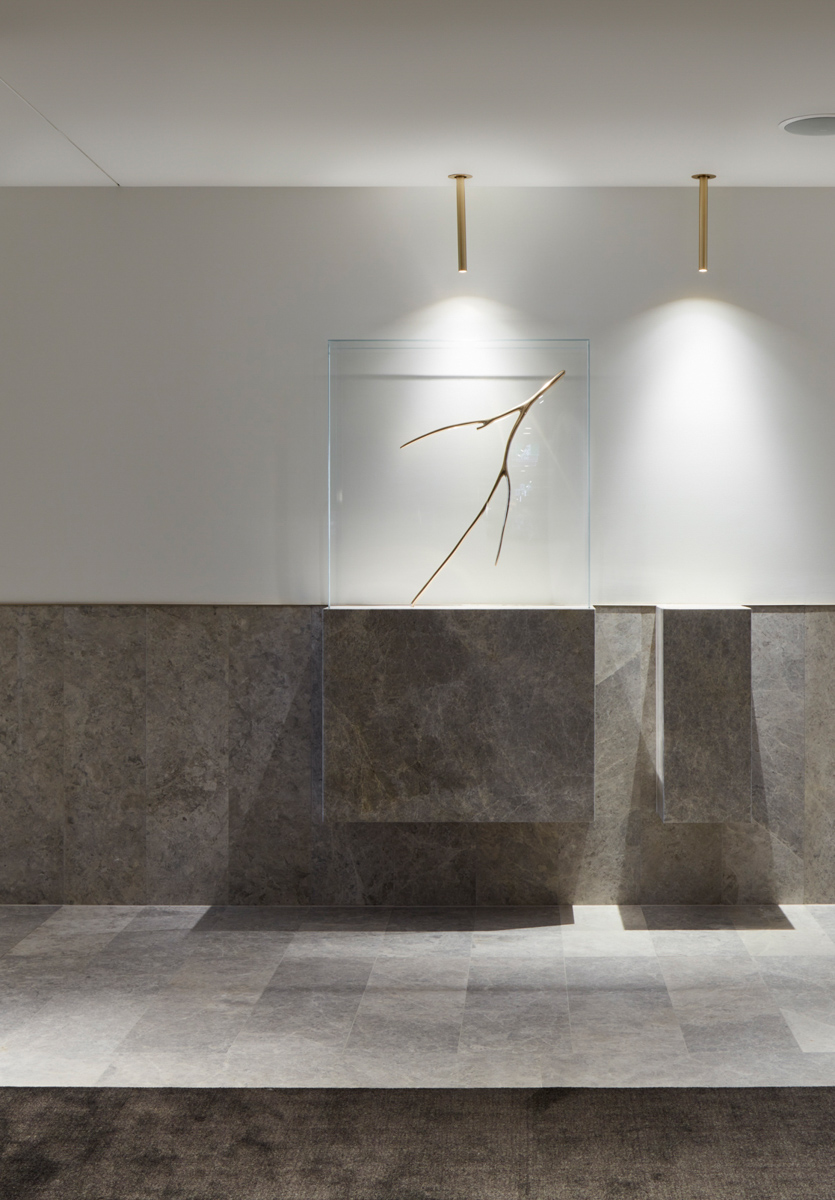
Work by Peter Syndicas
Now at the pool level, we’re shown a work by glass artist Jessica Loughlin, who has many works and studies on show throughout the building.
In the spa, where we’ve stopped briefly, there is an aesthetic of being in and amongst the clouds above. Jessica’s work, an ever changing constant xix, speaks directly to this, with sections of glass marked with long trails of stratus clouds.
“Clouds feature heavily throughout the whole project,” Mark says. “It’s something we wanted to connect back with place, and taking a little bit of a different stance on what place can be and how clouds can be interpreted, so a lot of the different artists have taken photos of clouds as they reference to South Australia.”
Some of the photographic cloud works have been shot by Alice Blanch and Jim Thalassoudis.
Mark worked alongside Jessica to find a colour palette that would suit the interior design. He also did this with glass artist Nick Mount, who has a work in the level eight lift lobby.
“He’s obviously one of the most renowned sculptors in Adelaide and internationally, known for his use of colour and texture. So when we said we wanted to have everything white, he was funny,” Mark says.
“White’s not just one colour, there’s so many different versions of white, and how do you get that? So this work talked to him exploring how you use whites.”
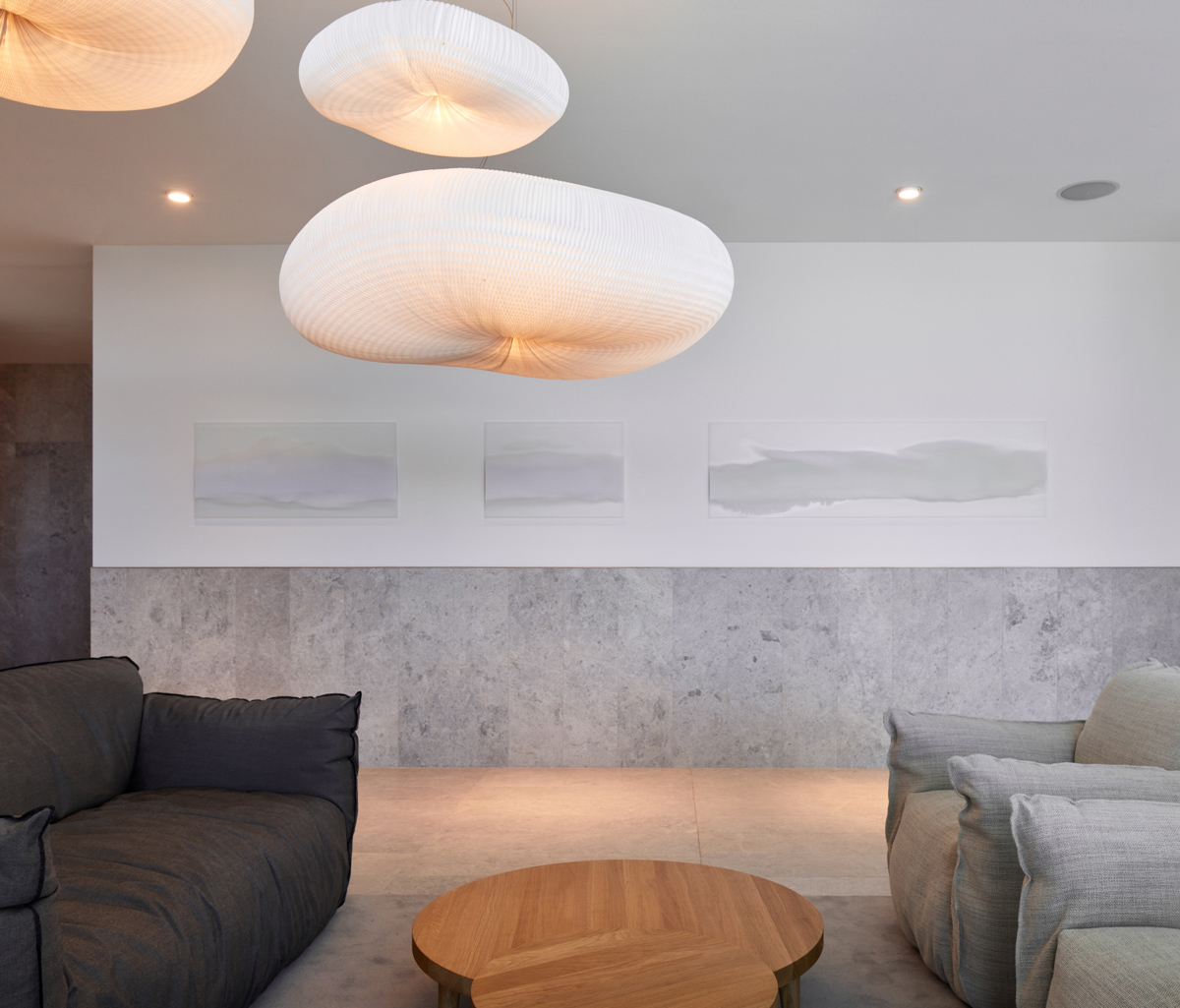
Work by Jessica Loughlin
In our tour, we’re mostly shown the public-facing sections of the hotel – accessible by anyone who dares give themselves a guided tour – but there are also works in the hotel rooms.
Selecting these works was quite contentious, Mark says. Not everyone agreed with his decision to make these works more dramatic.
Illustration works by Kate Bohunnis are heavy black and white creations that provide a point of difference to the light and ethereal works in the walkways.
“We really wanted to feel a little bit more dramatic, and probably a point of difference to other spaces.
“Not everyone liked the pieces that were selected, but once they saw the room come together, they understood why it had to be so dramatic.”
We leave the spa area and head to Sol Bar & Restaurant on level nine.
On our way to the restaurant, Mark stops us at three pieces hanging in a small corridor. Two are by Amy Joy Watson – painted landscapes, inspired by a trip to Arkaroola, that have also been embroidered – and one piece by Emmaline Zanelli (a one-time CityMag cover artist), which is a surprisingly engrossing image of quartz and kyanite, called The Bait Fridge Amulet.
These pieces are a soft introduction to the new aesthetic guests will notice as they move into Sol.
“Sol was a slightly different aesthetic. We worked with a different designer in here as well,” Mark says.
“This was a mix between local – because the food was going to be about local – and we really wanted to showcase some younger artists and some more established.”
There is a sculpture work hanging on the wall from Lesa Farrant – porcelain pieces “reminiscent of gumnuts”, Mark says.
There is also a piece from young Adnyamathanha artist Damien Coulthard (who is also a co-founder of Indigenous food business Warndu), which was commissioned, and which balances against a large piece toward the back of the space from a senior APY Lands-based artist Pepai Jangala Carroll.
“We saw [the Pepai Jangala Carroll] piece just before it went to an exhibition… To obtain something like that is really hard,” Mark says.
“Tracey made the call to the gallery so we could get first inspection and be able to get in there. We suggested the artist and hoped we could commission, but commissions weren’t possible, we had to go to with what was made.
“It was pretty exciting. It was kind of one of those moments that everything fell into place. We didn’t pick the colour or the tone or the design of it or any of it, it was just one of four that we thought was perfect for the space.”
Another large piece from Pepai is located in one of the hotel’s boardrooms (as seen in the main image of this story).
“That can only be seen by people who book the rooms, but at least the public get to see some of this great work,” Mark says.
Our tour concludes and we make our way to the concourse, where many guests will first be introduced to EOS.
Mark stops us one last time at a collection of large ceramic work by Connie Augoustinos.
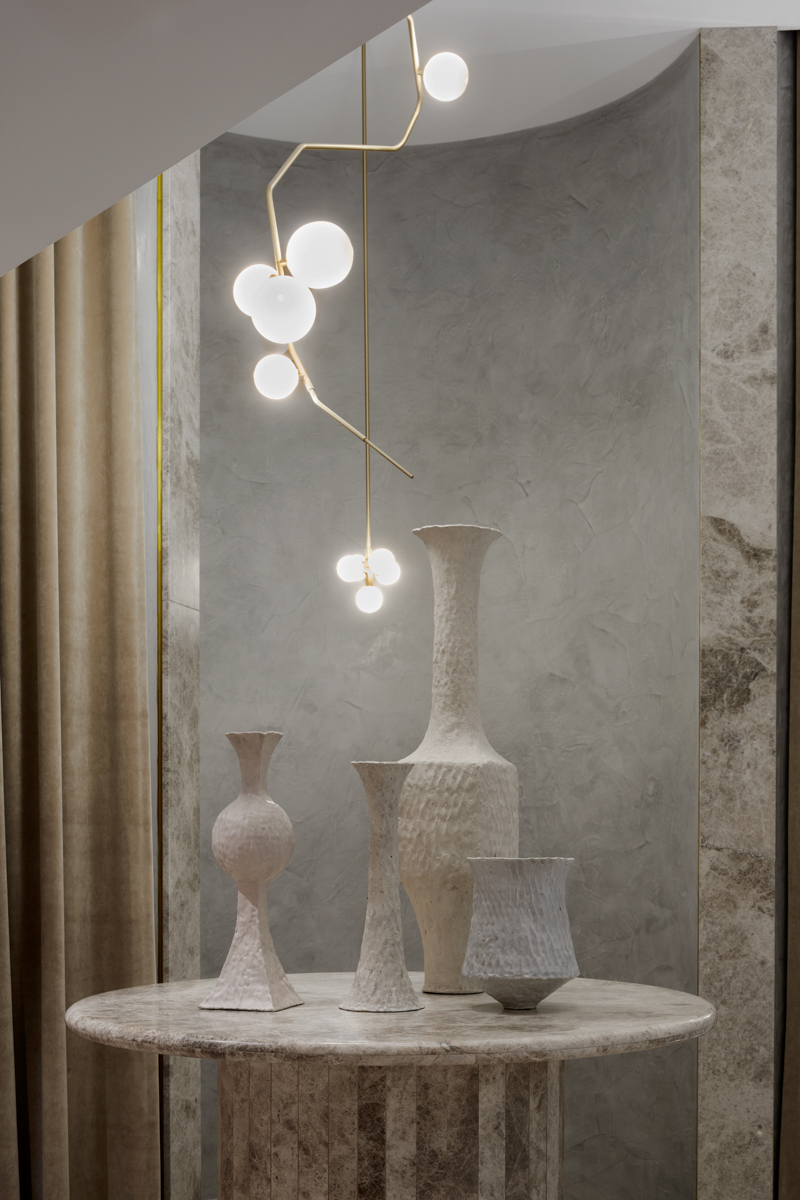
Work by Connie Augoustinos
The vases were commissioned and intended to communicate the domesticity of the interior design.
“It’s probably your first connection with a piece of art object – not what you’d usually see in a hotel lobby, and it very much sets the stage for the rest of the space,” Mark says.
“[These are] a slightly larger scale than is typically produced, because we needed something that had a bit of stature to it.
“But I think it’s just unexpected. You can touch it, feel it – that’s different to most artwork approaches.”
Taking a moment to admire the pieces, we leave Mark and EOS, having felt nothing at all like we’d spent an hour touring through a hotel. Instead, we got to see South Australia anew through the art and the curatorial work of Mark and his team.



